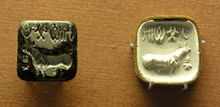Stamp seal
The dies were used to impress their picture or inscription into soft, prepared clay and sometimes in sealing wax.The oldest stamp seals were button-shaped objects with primitive ornamental forms chiseled onto them.[3] Romans introduced their signaculum around the first century BC;[3] Byzantine maintained the tradition in their commercial stamps.[4] In antiquity the stamp seals were common, largely because they served to authenticate legal documents, such as tax receipts, contracts, wills and decrees.The Indus stamp-seals probably had a different function from the stamp seals of the Minoan civilization, as they typically have script characters, with still undeciphered associations.

Urartianseal die6th millennium BCHalaf culturesealing wax4th millennium BCcylinder sealsRomanssignaculumByzantineantiquitystamp seals of the Minoan civilizationBrooklyn MuseumAncient Near Eastern seals and sealing practicesBulla (seal)Indus scriptLMLK sealsLachishScaraboid sealCylinder sealFeldman, Marian H.Oriental Institute of Chicago